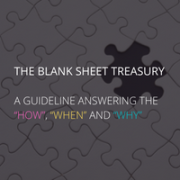Forecasting Through Disruption
11-05-2022 | treasuryXL | Cashforce | LinkedIn |
Despite the disruption to customer behaviour brought by the Covid-19 crisis, Pearson developed a consolidated forecasting process that has enabled it to speed up invoicing, accelerate £60m in cash flow and meet its 2020 targets.

Cash flow forecasting has long been recognised as a major challenge for corporations – and learning company Pearson, which has over 20,000 employees and reported sales of £3.4 billion in 2020, is no exception. “One of the challenges with forecasting is to understand what your assumptions are when producing the forecast,” explains Group Treasurer James Kelly. “When you’ve got lots of people producing forecasts independently, and then consolidating them, you need to have a consistent approach.”
Getting people to produce a forecast on time can be difficult, while treasury teams often spend precious time pursuing clerical accuracy. And as Kelly adds, “it is important to have enough detail in your actuals to really understand whether the hypotheses that were ventured in your forecast have actually come to pass.”
Forecasting during a pandemic
The latter is particularly important in times of uncertainty – and few things are as unpredictable as the onset of the Covid-19 pandemic. For many organisations, the crisis meant that cash flow forecasting became significantly more challenging overnight, not least because disrupted customer behaviour meant that forecasts based on historical sales patterns could no longer be relied upon.
For Pearson, with the company’s professional test centres forced to close due to lockdowns, a major challenge came in the form of refunds that had to be issued to customers for tests that had been booked in advance – a situation that was complicated by the differing ways that customers could respond. Some rebooked straight away; some requested an immediate refund, and others waited for a couple of weeks before requesting a refund. And when requesting a refund, customers could either apply to Pearson directly, or request a refund via their credit card companies. All these different scenarios impacted the company’s short-term modelling.
The path to better forecasting
While the challenges were considerable, Pearson’s treasury had already been on a journey to more effective forecasting before the pandemic began – indeed, the automation of cash forecasting formed part of a treasury and cash management optimisation project that won a EuroFinance Treasury Excellence Award in 2019. The company subsequently adopted Cashforce’s AI-powered forecasting system, and continued to work on improving its processes. However, when the pandemic started it was clear that a more comprehensive approach was needed.
“What was interesting about Covid was that some of the basic models that we built around predictable cash flows broke,” Kelly comments. “We were able to keep using some of our models for things like payroll – but on the receipt side, a lot of things that had previously been predictable now became unpredictable.” What this meant was that the forecasting ability of the system almost became redundant – “and the benefits of the solution became more about hypothesis testing, and as a consolidation engine that allows you to build different scenarios.”
With the onset of the pandemic, each business produced a high, medium and low sales forecast, which the treasury team used to build its own set of forecasts. While this exercise was initially carried out using Excel, the treasury’s Cashforce-based 12-week forecast demonstrated good levels of accuracy, as well as integrating with key group systems. As such, the system was selected as the basis for the new approach to producing short, medium and long-term forecasts in 16 categories, later expanded to include 120 subcategories.
Building a map of cash flows
Pearson’s functional currency is GBP, so with considerable variability in the company’s US profits another question was how to use the forecasting information to hedge currency risk. Again, this drew upon the low, medium and high scenarios: forward contracts were used to hedge committed or highly probable foreign currency flows for the low scenario, with collars and options used to provide protection for the medium and high scenarios.
Benefits of the project
Pearson has seen numerous benefits as a result of its enhanced forecasting process. Preparing forecasts centrally has freed up significant time for the operating companies, as well as enabling forecasts to be updated daily, instead of weekly or monthly. And Kelly notes that forecasts are now significantly more accurate than they were in 2019, despite uncertainty relating to the pandemic.
Further, Pearson has been able to use insights from the forecasting process to drive better performance in its working capital metrics – in particular, lower DSO, lower variability in DSO, and faster invoicing speed. These initiatives accelerated over £60m of cash flow in 2020, enabling Pearson to achieve its objective of delivering operating cash flow of over £300m, despite the pandemic.
Above all, the crisis has acted as a catalyst for Pearson to rethink the nature and purpose of forecasting. As Kelly concludes: “Whether the forecast is right or wrong becomes less important than understanding why it’s right or wrong. So the game we were playing wasn’t to get the forecast right on any particular day, but to have a good understanding of the business over time – which then enables you to get it right.”









